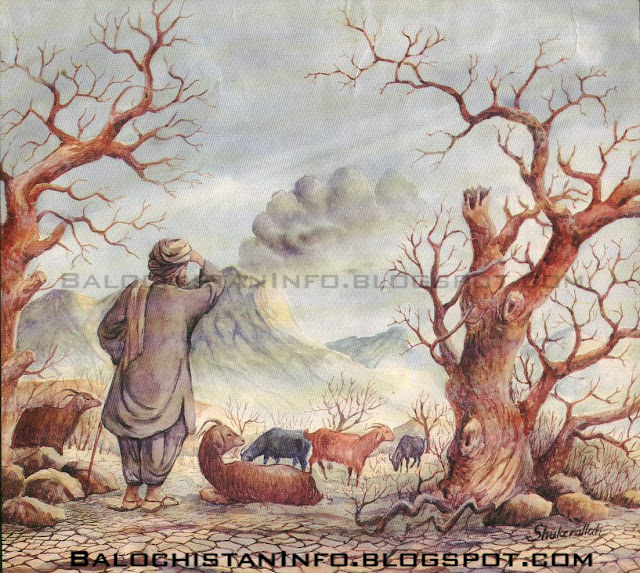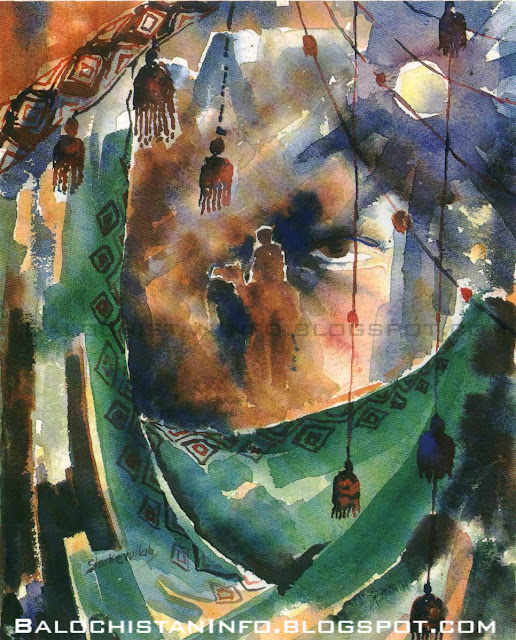Sardar Ataullah Khan Mengal popularly known as Sardar Ataullah Mengal, is a
well known political figure of Pakistan hailing from Balochistan.He has been
campaigning a nationalist and separatist movement in Pakistan for over four
decades. He is the head of the Mengal tribe. He was born in 1929 in Wadh,
became the first Chief Minister of Balochistan during Zulfiqar Ali Bhutto's
Premiership from May 1, 1972 to February 13, 1973.
In 1969 Mengal along with other Baloch friends joined the National Awami
Party (Wali) of Khan Wali Khan and developed a close friendship with Wali Khan
over the next decade. Elected to the provincial Assembly in what was a NAP
sweep of Baluchistan he was elected Chief
Minister by his party. In his short time as Chief Minister he pushed through
many initiatives, in which the province's first university, medical college and
board of secondary education were set up as well as the first industrial city
of the province, in Hub. Despite his best efforts the NAP government was
plunged into several crises which culminated with his governments dismissal.
The first of which was when the Baluchistan
police department, mostly officered by people from Punjab
or were Punjabis. As there was a provision that employees in the federating
provinces would return to their province of origin after the dissolution of the
One Unit. Most of the officers insisted on leaving this was despite the fact,
Sardar Ataullah Mengal as chief minister moved a resolution in the Balochistan
Assembly to do away with the domicile category and suggested that those who had
spent several generations in the province should be treated as locals (Rahman
2006). It was later on alleged that the officers were incited to leave through
the efforts of PPP supporters and the then Chief Minister of Punjab Ghulam
Mustafa Khar. Unable to exercise any effective authority Ataullah Mengal turned
to the Baloch Student Organisation to assist in security. This in addition to a
subsequent intra tribal conflict that broke out (which again Baloch
Nationalists believe was fermented by the Interior Minister at the time), as
well as the discovery of arms in the Iraqi embassy and Nawab Akbar Bugti's
declaration of the London Plan and arms shipment from Iraq to dismember
Pakistan by the National Awami Party was used as a pretext for the dismissal of
the Baluchistan provincial government. Mengal and his colleagues, including
Ghaus Bux Bizenjo and Nawab Khair Bakhsh Marri were arrested along with other
NAP colleagues. It was during this time that one of Ataullah Mengal's sons,
Asadullah Mengal, was killed and taken away by intelligence agencies in Karachi outside the home
of the Mazari tribal chief Mir Balakh Sher Mazari.
The tribunal known as the Hyderabad
tribunal was used to convict them despite it's dubious legality and now
discredited work. Late Zulfiqar Ali Bhutto, the then prime minister of Pakistan, suppressed
the insurgency in Baluchistan by using its air
force and with the cooperation of the regime of the Shah of Iran. Some tribals,
however, did not join the revolt and collaborated with the government in
suppressing their co-tribals. Among the tribals who collaborated with the
government and the Pakistani military-intelligence establishment were the
Jamalis, led by the family of Mir Zafarullah Khan Jamali, who was premier of Pakistan just
before Shaukat Aziz.
After the ouster of Zulfiqar Ali Bhutto's government by General Zia-ul Haq,
negotiations for the winding up of the Hyderabad tribunal and the release of
all detainees was initiated leading to their eventual release in 1979. By this
time a clear divide between Wali Khan and his friends Ataullah Mengal and Ghous
Bux Bizenjo. Mengal and many other Baloch Nationalists increasingly believed
that the Army was responsible for a brutal military operation and that they
should be opposed by force, whereas Wali Khan felt more personal bitterness
towards Zulfiqar Bhutto as he felt Bhutto had ordered his assassination on more
than one occasion. This divide turned into a total split when Ataullah Mengal
allied himself with Khair Bakhsh Marri and attempted to take over the National
Democratic Party (a successor to the then banned NAP). Sardar Sherbaz Khan
Mazari ,President of the National Democratic Party and a champion for the
Baloch cause tried to reconcile these differences but did not succeed. When
this attempt failed Ataullah Mengal left the party. He subsequently went into
exile and took sanctuary in the UK,
where he established contact with the authorities of the erstwhile USSR through
the regime in Kabul
and received financial and logistics support from Moscow.
When the Central Intelligence Agency (CIA), through Pakistan's
Inter-Services Intelligence (ISI), trained and armed the Afghan mujahideen and
other Islamic fundamentalist elements and used them to bleed the Soviet troops
in Afghanistan, the Marris and the Mengals kept away from the anti-Soviet jihad
and helped the KGB, the Soviet intelligence agency, and the KHAD, the Afghan
intelligence agency, in the collection of intelligence regarding the activities
of the CIA and the ISI on the Pakistani side of the border.
Sardar Ataullah Mengal returned to Balochistan
in the mid-1990s, after which he formed the Balochistan National Party, which
emerged as the largest political party in the province. Mengal's youngest son,
Sardar Akhtar Mengal served as the Chief Minister of Balochistan in 1997, during
the premiership of Nawaz Sharif.
Retrieved from "http://en.wikipedia.org/wiki/Ataullah_Mengal

































